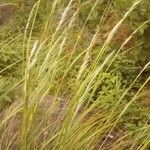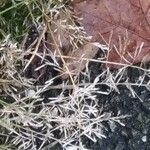Spikelets 5–7(15) × 1.5–1.8 mm, narrowly oblong to linear, laterally compressed, 9–12(25)-flowered, the lemmas disarticulating from below upwards, the rhachilla persistent; glumes unequal, keeled, lanceolate in profile, scaberulous on the keel, eglandular, acute at the apex, the inferior 0.8–1.5 mm long, reaching to between 1/2 and 3/4 the way along the adjacent lemma, the superior 1.3–2.1 mm long, reaching to about the middle of the adjacent lemma; lemmas 1.7–2.3 mm long, keeled, oblong-lanceolate in profile, chartaceous with distinct lateral nerves, diverging from the rhachilla at less than 45°, those in opposite rows scarcely imbricate, the rhachilla ± visible between them, green to leaden-grey or reddish, scaberulous on the keel, eglandular, obtuse at the apex; palea persistent, glabrous on the flanks, the keels slender, wingless, scaberulous; anthers 3, 0.2–0.3 mm long.
Laxly tufted annual to 300(600) mm high, erect to geniculate; culm nodes with or without glands below. Leaf blade to 100 x to 3.5 mm; margins eglandular, scabrid. Inflorescence open, primary branches usually not longer than 40 mm, spreading, not whorled; axils glabrous; pedicels stout, crateriform glands usually present. Spikelet 5-15 x 1.0-2.2 mm, rachilla persistent, lemmas and/or paleas breaking up from base upwards; glumes unequal sometimes almost equal on same inflorescence, apex acute; lemma 1.7-2.3 mm long, obtuse, keeled, lateral nerves distinct, glabrous, scaberulous; palea persistent, keels slender, scabrid, margins very wide apart; anthers 3, 0.2-0.3 mm long; caryopsis oblong-elliptic.
Erect to geniculate, laxly tufted, annual, up to 300 mm high. Leaf blade up to 100 x 3.5 mm; ligule a fringe of hairs. Inflorescence an open panicle, primary branches usually not longer than 40 mm, spreading; pedicels stout. Spikelets 5-15 x 1.5-1.8 mm, laterally compressed; rachilla persistent, lemmas and/or paleas breaking up from base upwards; glumes unequal, shorter than spikelet, 1-nerved. Florets many; lemma obtuse, entire, 3-nerved; palea keels scabrid; anthers 3, 0.2-0.3 mm long. Flowering time Dec., Jan. Caryopsis oblong-elliptic.
Annual; up to 0.3 m high; laxly tufted; erect to geniculate. Leaf blades up to 100 x 3.5 mm. Flowers: panicle open; primary branches usually < 40 mm long; spreading; pedicels stout; spikelets 5-15 x 1.5-1.8 mm; spikelet rachilla persistent; lemmas and/or paleae breaking up from base upwards; glumes unequal; lower glume large; distinctly keeled; lemmas 1.7-2.3 mm; obtuse; palea keels scabrid; anthers 3; 0.2-0.3 mm long; caryopsis oblong-elliptic.
Annual, laxly tufted (erect to geniculate), up to 300 mm tall. Leaf blades up to 100 mm long, up to 3.5 mm wide. Spikelets 5-15 mm long, 1.5-1.8 mm wide. Inflorescence open, primary branches usually not longer than 40 mm, spreading, pedicels stout; spikelet rhachilla persistent, lemmas and/or paleas breaking up from base upwards; glumes unequal; lemma obtuse; palea keels scabrid; anthers 3.0,2-0.3 mm long. Caryopsis oblong-elliptic.
Loosely caespitose annual; culms up to 40(60) cm tall, erect or ascending, branched or unbranched, glabrous at the nodes, with or without glandular pits below the nodes, these often coalescent into a ring; leaf sheaths glabrous, eglandular; ligule a line of hairs; leaf laminas 3–13 cm × 2.5–3.5 mm, linear, flat or involute, glabrous, eglandular.
An erect annual grass. It forms tufts. It often has an aroma. It grows 10-45 cm high. The leaf blades are 10 cm long by 5.5 mm wide. They can be flat or rolled inwards. The flower panicle is 3-20 cm long and sword shaped. It is usually open with stiff branches. The flowers are green and purple. The seeds are up to 1 mm long and dark brown
Panicle 7–16 cm long, oblong to ovate-oblong, open, stiffly branched, the spikelets evenly distributed on pedicels 1–3 mm long, these with one or two crateriform glands, the primary branches not in whorls, terminating in a fertile spikelet, glabrous in the axils.
Closely resembles E. minor, differing in the narrower unequal glumes, longer appressed lemmas and eglandular leaf margins.
Caryopsis 0.6–1 mm long, elliptic-oblong, very rarely shorter and broader.


